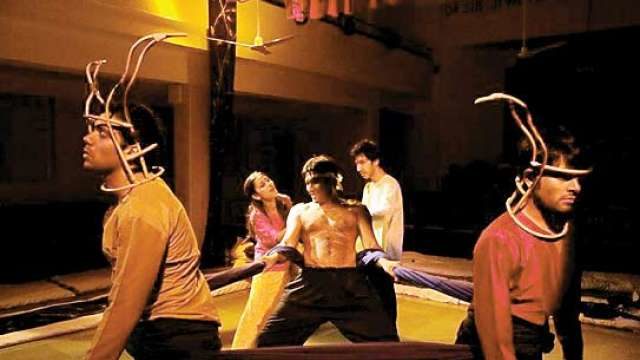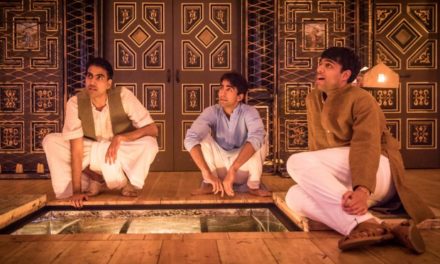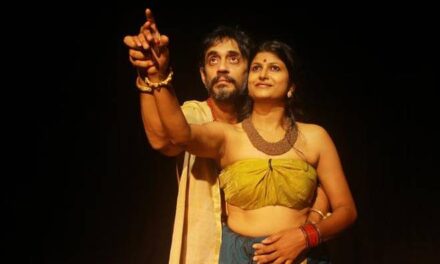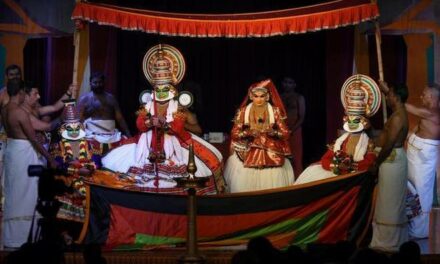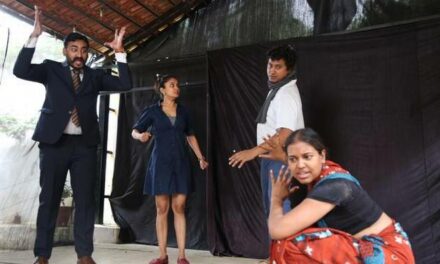Philosophical deliberations upon the relationship of literature with theology have become redundant today, as the critic is justifiably more concerned with the work in question, and not the theological/moral value of the work, unless and until a text is a product of a context that is inextricably linked with theology. However, the study of the relationship of the former with the latter becomes all the more interesting in the Indian context when we eschew reading religion in narrow institutional terms and substitute ‘spirituality’ in place of ‘religion’ to understand the source of creative inspiration as the quintessentially Indian theorist would see it. Of late, there seems to be a tendency among scholars of literature in India to increasingly bank upon Western paradigms of criticism and theory. The tendency commonly cuts across scholarship on literatures written almost in all the vernacular languages and English in particular. It all begins in Aristotle and ends in likes of Roland Barthes and Hans Robert Jauss. Trends in critical practice shift with shifting perspectives in the social sciences and humanities scholarship and pedagogy. In the process, the pleasures of literature and creative expression sink under the weight of critical scholarship imported from the West.
To set our feet firm on the ground of the Indian soil, it may help us a bit if we turn back to the pages of Tagore, who in his own simple manner attempts to understand creativity and its source. In the process what is generated is an entire body of scholarship on a theory of literature. In an essay titled ‘Sahitya‘ or ‘Literature’ composed in 1924, from a collection of essays called Sahityer Pothye, first published in 1937, Tagore in his attempt to define creativity and the art of creative expression, ends up establishing a subtle relationship between artistic expression and a spiritual quest. Art, as he points out arises out of an innate quest to express the infinite. That is what differentiates art from the empirical sciences, whose primary objective is to know how to fulfil material needs. But art, according to Tagore, arises out of the consciousness of being part and parcel of the Universal. Tagore explains this phenomenon as the artists’ unique prakash-tatva, which may be taken up by scholars in search of a quintessentially Indian theory of art and literature in the twentieth century. Again, in the same essay, Tagore enlightens the reader on his discovery of a new alternative synonym of the artist. Citing instances from the pleasures of hearing a recitation of Kalidasa’s Meghdoot or a moving musical composition, Tagore observes how the effect of art remains long after it is heard or seen.
Similar passages from Tagore remind us of the long lost Indian tradition of studying the aesthetics of theatre in the light of emotional relish or rasa partaken of by the aesthete during a performance, as the sage Bharatmuni goes on to document and establish in the Natyasastra, the encyclopedia of performance forms. The exact, or even tentative, date of the composition of the Natyasastra is difficult to ascertain or even guess. However, after the first century A.D, commentators of the work such as Bhattanayak, Bhattalollat and Sankuta, have penned down their observations and inferences on the rasa theory. But the tenth century renowned exegete of Bharatmuni, Abhnavagupta, in his famous commentary on the great work, establishes the rasa theory of drama exclusively upon a spiritual base, that of the principles of Kashmir Shaivism. Known as the Abhinavabharati, this commentary on the ‘rasa’ doctrine of Bharatmuni, defines the emotional state of the aesthete during the stimulation of rasa in the theatre as a re-cognition (abhigyan) of the essence of the respective emotional state. Every permanent emotional state or ‘sthayi bhava’ is part and parcel of the universal self or the shiva. Shiva, to the Kashmir Shaivist Abhinavagupta, represents the ‘Universal’ or ultimate truth, and every material state that man passes through is part and parcel of that ‘Universal.’ A fictional exposure of the human subject to any one or more of the eight emotional states in a dramatic experience may connect man to the ‘Universal.’ Abhinavagupta calls this realization of the essence of an emotion leading to the relish of the respective rasa abhigyan or re-cognition – a remembrance of that which has been forgotten by man in his pursuit of the material. Abhinavagupta’s theorizing on the concept of rasa confirms that ancient Indian drishya-kavya or ‘the spectacle in the theatre’ had a spiritual foundation, based upon the concept of abhigyan or re-cognition. A dramatic experience was thus more of a self-exploration or self-recognition, or pratyabhigyan. The actor, engaged in simulating/representing a sthayi bhava according to the ancient mechanics of theatre, was required to conceptualise the pratyabhigyan theory of theatre. He (the actor) thus was the primary means through whom rasa could have been stimulated in the mind of the spectator.
Gradually, under the influence of diverse socio-political factors theatre in India lost its link with its innate spiritual roots. Girish Karnad in his 1989 essay “Theatre in India” confirms how by the end of 1000 A.D the ancient Sanskrit tradition was gradually dying in Indian theatre, with only the indigenous folk performance traditions staying on in regional languages, to survive the onslaught of time. He also points out to the difficulty on the part of critical scholarship to define what constitutes the truly ‘Indian’ in Indian theatre, for playwrights have had to choose from either the ancient Sanskrit tradition which had been dead by 1000 A.D, or the indigenous folk performance traditions such as the yakshagana, the kathakali, ritual forms such as the raslila and ramlila, forged out of the bhakti movement, to name only a few, and numerous other folk traditions.
‘Modernity’ in Indian theatre was no doubt to a great extent a colonial import, with English theatres opening up in colonial Calcutta since 1775 catering to the tastes of the haloed circle of the then Governor General Warren Hastings. Erin B. Mee observes,
In Bengal, many theatre historians date the beginning of modern theatre to the year 1795, when the Russian Gerasim Stepanovich Lebedeff (1749 – 1817) translated the English play The Disguise into Bengali, and produced it with a cast of Bengali actors. (47)
Similar ‘modern’ trends were visible in the theatres of other Indian languages. Playwright and essayist Bharatendu Harishchandra (1850 – 1885) revolutionized Hindi theatre in the late nineteenth century by re-defining the concept of drama in India that was gradually evolving into a genre that was urban and ‘high-brow,’ distancing itself from the indigenous rural performance traditions that remained on the peripheries of the space of Indian theatre. Referring to Harishchandra’s adaptation of a Sanskrit play Chandrakaushika, and his 1883 essay “Natak,” Mee observes how Bharatendu Harishchandra sought “to produce a new aesthetics of drama, which draws upon the old while integrating the new” (48). Later, Mee investigates further to reveal that Shanta Gokhale in her history of modern Marathi theatre Playwright at the Centre (2000) begins her history not with the indigenous performance traditions of Maharashtra such as the Lalit, Bharud or Tamasha, but with the 1843 production of Sita Swayamvara by Vishnudas Bhave. According to Gokhale, this production was “the first non-traditional, non-folk, non-ritualistic dramatic production in Marathi and the first performance in Marathi that could be called a play” (qt.in Mee 48-49). This was also “the first play to fit the colonial definition of theatre…Sita Swayamvara represents a transition from performance-based theatre to literary-based theatre” (49).
Vishnudas Bhave’s production thus went on to pave the way for the transition from the term khel (play/performance) to the term natak (drama) as Mee goes on to point out in his book Theatre of Roots: “Significantly, it was around this time, in 1855, that the term khel (play-performance) gave way to the term natak (drama) in newspaper reviews and advertisements” (51). A new audience gradually emerged with the coming up of private patronage, advertisement campaigns, ticket sales and advance bookings “scheduled at times that had nothing to do with a ritual or harvest calendar and everything to do with the social calendar of the urban elite. Theatre, once a community event, was now a commodity available only to those who could afford it (52). Theatre in modern India thus gradually and affirmatively moves away from the ritual and the sacred into the domain of realism and commerce. The primary objective of theatre moves away from its spiritual quest to a quest for representational strategies. Representation became the primary object of drama, either of an external, material reality or an abstraction. However, under the influence of postcolonial attempts to re-discover roots of Indian theatre, the ‘theatre of roots’ movement was institutionalized under the patronage of the Sangeet Natak Akademi, “whose main function was the discovery, retrieval, and rejuvenation of arts on the brink of extinction” (Karnad 345). The works of Kavalam Narayana Panikkar and Girish Karnad may be cited as attempts to reach out to the roots of Indian theatre. Panikkar calls such theatre thanathunatakavedi, or ‘our own theatre,’ combining
the dramaturgical structure of Kutiyattam, the actor training methods of Kathakali, the physical training of Kalarippayattu and aesthetic theory from the Natyashastra and Abhinava Bharati with staging patterns dictated by the perspectival requirements of the proscenium stage in a relatively fixed, repeatable production. (Mee 95-96)
His productions such as Ottayan (1985) and Urubhangam (1987) serve as “quintessential examples of his larger body of work” (Mee 96). Mee’s assessment of Panikkar’s work clearly points out to the relationship that a theatre-of-roots worker shared with Abhinavagupta’s theory of self-recognition or pratyabhigyan, pertaining to both the actor as well as the spectator for a complete theatrical experience leading to the stimulation of the rasas including the Santa-rasa. A similar assessment can also be applied to an understanding of Girish Karnad’s Hayavadana, the poster-play of the theatre-of-roots movement.
But a serious difficulty arises when such theatre is de-contextualised from its ritual matrix in its modern performance spaces restricted to urban glitzy auditoriums in which audience is restricted. With active media partners from corporate houses, tickets are priced anywhere between rupees five hundred to one thousand. The difficulty stated above is not new to the modern theatre in India, of having to straddle between two worlds in the auditorium – the ritual world of ancient India, and the globalised world outside, particularly with the cell phone beeps interrupting the engagement of the involved spectator. The difficulty has been
The difficulty has been naturalized in the post-modern Western theatre too, in that of Stanislavski, Jerzy Grotowski, Peter Brook and Richard Schechner, who have gone back to Indian roots with vengeance in order to resist the boredom of realism and the proscenium conventions. But nevertheless motivated attempts at recreating a lost heritage have never ceased both in the West as well as in India. Among the various reasons logically substantiated and assumed are two well-established views, as pointed out by Vasudha Dalmia: “The East has often been convinced that it is the bearer of spiritual traditions no longer accessible in the ‘West,’ and the ‘West,’ tiring of the breakneck speed of the business of living in industrial and post-industrial society, has often looked for succor to the ‘East'” (282). Pages culled from the theoretical works of some of these theatre practitioners would confirm Dalmia’s claim. She describes such tendencies as “reductivist,” “partial,” “orientalist” and “restricted often to a preoccupation with technique” that had lead to a “deliberate desacralization of context” (284). Such inspirational practices have “seldom been accompanied by any serious attempt to understand the historical, social, aesthetic, and most of all religious context of the performance tradition thus abstracted (284). Dalmia points out to the fallacies involved in such attempts that may be misleading for scholars. Referring to Schechner’s re-working of the Ramlila, she observes, “The hazard consists in the arbitrary mode of transportation of the ritual concerned and the subsequent lack of reflection concerning the creation of new meaning” (286). According to her, Schechner seems to revel in his new found technique, celebrating “with post-modern felicity, the fragmentation and transportation of ritual processes from their own context into other, disparate ones (286). Schechner’s gross oversimplifications of ancient Indian theatre’s spiritual connect are exposed in the following lines penned by him:
These apparently different systems view experience as what the Hindus call maya and lila – illusions and play – a construction of consciousness. The ‘ultimate reality’ lies somewhere else – in the genes say the sociobiologists; in the flow of goods say the economists; in the exchange of information say the multinationals. What about post-modern performance?…Post-modern means something close to what postwar means: the organizing of experience in a period when experience is maya – lila . (qt in Dalmia 287)
Rustom Bharucha in his work Theatre and the World: Essays on Performance and Politics of Culture (1990) assesses Peter Brook’s adaptation of the Mahabharata. Referring to Bharucha’s critique, Dalmia argues:
According to Bharucha, since the Bhagavadgita is reduced to a five-minute encapsulation, it can possess little of the function it could have as a possible part of the referential framework. In fact the play lacks such a frame altogether. The New York audiences laughed when they heard Krishna advise Arjuna: ‘Act, but don’t reflect on the fruits of action.’ At such moments the overall banality and triteness of the Carriere-Brook text becomes particularly apparent. Such is also the case when it comes to the general references to dharma. (291)
Undoubtedly, Panikkar and Karnad do not seem to lend themselves to such vitriolic criticism. Ancient Indian techniques of theatre belong to the repertoire of our tradition. But Dalmia’s assessment throws open new frontiers of judgment in modern Indian theatre scholarship, allowing the critic/spectator to read into the use of these museumized techniques and derive new meanings from them. Aparna Dharwadker observes that this was the beginning of syncretism in modern Indian theatre which straddled between “two major systems of theatrical representation – Indian and European, classical-traditional and modern, antirealistic and realistic, provincial and metropolitan” (3). For instance, within the ambit of modern Indian drama/theatre, Girish Karnad’s uniqueness lies in his synergetic blending of all the elements associated with modernity and the pre-modern in what appears to be a “syncretistic modernity” (5). An aspect of this syncretistic performance culture of post-independence India is the assimilation of drama to literature and textuality, being open to performance practices within the matrix of urban print culture in India. It is worth noting in this context that urban print culture gives birth to the notion of “drama” in post-independence India which Dharwadker defines as “the aggregation of texts” in addition to “theatre” which she defines as “institutionalized performance” comprising “strategically interrelated and interdependent activities: the styles of authorship, production, reception, and criticism” (3).
Girish Karnad’s drama/theatre as in plays such as Hayavadana, The Fire and the Rain, Nagamandala, Flowers and Bali: The Sacrifice among others, must be understood in this matrix of urban performance. Karnad’s dramaturgy underscores the popularity of a unique twentieth-century urban sensibility that has conveniently acknowledged the fusion “of an antirealist, antimodern, non-Western, body-centered (rather than word-centered) theatre aesthetic rooted in indigenous performance tradition” (Dharwadker 102), and the textual, discursive drama of the proscenium stage. Among some of the first causes behind the genesis of such fusion theatre, mention must be made of the entry of the film as a realist art form in the 1930s – more commercially viable – that paved the way for a virtual extinction of the then urban realist theatre. Moreover, being a less commercial, urban enterprise in comparison with the cinema, theatre found itself in a particularly disadvantageous relation to the popular and mass media as the core urban audience for a serious theatre is a miniscule fraction of the total audience for film and television across India.
Girish Karnad’s drama occupies a special position in the history of ‘modern’ Indian theatre both by virtue of its identification with an audience that is urban and of its careful espousal of realism that had been particular to films. Instead of emulating the mimetic realism adopted by films, he chose modes of representation that established an alternative and autonomous artistic identity for theatre. A close reading of Karnad’s 2004 play Flowers, a monologue, would demonstrate how Karnad achieved his aim in successfully walking the tightrope between urban literary drama and the non-realistic folk forms Karnad. The language of the play, despite its folk setting, has been very consciously chosen so as to cater to an urban audience, which becomes evident as we read through the play, despite its folk setting. There are several such plays based on myth, legend, history and folklore in Girish Karnad’s repertoire. Yet it is important to remember that he is essentially an urban playwright and theatre worker whose audience is urban too. His plays, it may be mentioned, are performed primarily in urban spaces. Statistics make it quite evident that most of such plays based on myth and folklore cannot in any way be called rural, or be conceived of as being targeted at a rural audience with any sort of theological intention. The same is true of plays penned or directed by Habib Tanvir, K.N. Panikkar and Ratan Thiyam. Aparna Dharwadker observes, “Although these authors occupy varying positions of proximity and distance from the folk cultures they represent, their plays are uniformly not in themselves the products of folk culture” (320). In her search for an ideal term for a comprehensive understanding of such folk practices within the parameters of urban performances, she stumbles upon the term “urban folk” (320) to refer to such plays primarily on the basis of their indebtedness to the culture of textuality and print.
However, one must also note here that this urban tendency to textualise theatre in modern India is strangely and ironically at odds with Western postmodernist theatrical tendencies, such as that of Jerzy Grotowski and Peter Brook, who have valorized performance over the text. Grotowski observes in this connection: “I have studied all the major actor-training methods of Europe and beyond…Also particularly stimulating to me are the training techniques of oriental theatre – specifically the Peking Opera, Indian Kathakali, and Japanese Noh theatre” (16). Michael Vanden Heuval calls this tendency of Western practitioners an “aversion to textuality and a consequent interest in the deconstructive resources of performance” (qtd. in Dharwadker 59). However, despite postmodern Western preferences for pre-modern, non-proscenium modes of performances, Karnad chose the mediations of authorship, intentionality, and textuality. His choice indicated that his theatre, instead of being a replication of folk performances, would aspire after an autonomous form with its own aesthetic, cultural, and political objectives in relation to a predominantly urban audience. However, such artistic autonomy entails a few responsibilities, which Karnad might have been aware of. First and foremost, it is important for the playwright to bring a contemporary sensibility to bear on folk forms. This may be made possible by choosing themes and motifs that may have archetypal resonances in the sensibilities of modern audiences, or may act as mythical prototypes to address questions that fail to be answered by modernity. Besides, the rural subject matter, form, styles, staging conventions may technically be alien to urban spectators and sites of performance. Hence first the playwright, and then the director, must take great care to ensure its success in non-folk locations by highlighting the old conventions through plastic means such as the use of digital acoustics within and beyond the proscenium. The awareness of this responsibility on the part of the playwright of urban folk calls for a unique syncretism.
Works Cited:
Dalmia, Vasudha. Poetics, Plays, and Performances: The Politics of Modern Indian Theatre. New Delhi: Oxford University Press, 2008.
Dharwadker, Aparna Bhargava. Theatres of Independence: Drama, Theory, and Urban Performance in India since 1947. New Delhi: OUP, 2005.
Grotowski, Jerzi. Towards A Poor Theatre. London: Methuen Drama, 1991.
Karnad, Girish. “Theatre in India.” Daedalus 118.4 (Fall, 1998): 330 – 352. JSTOR. Web. 11 Aug 2011.
—. “Flowers.” Collected Plays Volume Two. New Delhi: OUP, 2005.242 – 260.
Mee, Erin B. Theatre of Roots: Redirecting the Modern Indian Stage. London and New York: Seagull Books, 2008.
Rangacharya, Adya. The Natyasastra: English Translation with Critical Notes. New Delhi: Munshiram Manoharlal Publishers Pvt. Ltd, 2003.
Tagore, Rabindranath. Sahityer Pothye. Kolkata: Visva Bharati, 2008.
This article was originally posted on MuseIndia.com. Reposted with permission. To read original article, click here.
This post was written by the author in their personal capacity.The opinions expressed in this article are the author’s own and do not reflect the view of The Theatre Times, their staff or collaborators.
This post was written by Partha Sarathi Gupta.
The views expressed here belong to the author and do not necessarily reflect our views and opinions.

